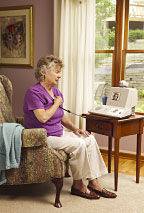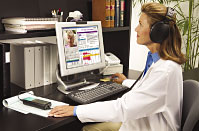 |
 |
 |

January / February 2005

Viewpoint
Telehealth Programs —
Introducing the Basics

By Randall S. Moore, MD, MBA
In just one year, 81-year-old Dorothy was hospitalized 13 times for problems related to congestive heart failure (CHF). After participating in a telehealth program for 34 months, Dorothy's health status improved significantly, and she had no CHF-related hospitalizations. The telehealth program connected Dorothy to her clinical team by combining medical devices with audiovisual capabilities. To put it more simply, while in her home, Dorothy could interact with clinicians much the same as if she came into the clinic or emergency room (ER). That capability — available 24/7 — means that any change in the patient's condition can be detected quickly. Dorothy's story is not unique; it is indicative of the type of results seen when patients play a considerable role in their healthcare solutions.
In our nation's healthcare system, patients haven't always been active participants in their care. The introduction of telehealth into the healthcare arena is helping to change that attitude. With a philosophy that healthcare should begin and end with the patient, telehealth offers patients more control, more access to their clinicians, better knowledge of their condition, and greater peace of mind.
What Is a Telehealth Program?
The first video telehealth unit, which provided live audiovisual communication and the ability to use a stethoscope, measure blood oxygen, and check blood pressure, was unveiled nearly 11 years ago. Over the years, this innovative technology has been further enhanced and developed and is now being used by thousands of people throughout the United States and Canada. Without leaving the office or clinic, doctors and nurses can make personal "visits" to patients at home, using state-of-the-art technology that simultaneously transmits voice and video combined with clinical data streams from medical peripherals such as blood pressure monitors, stethoscopes, and glucose meters — all over standard telephone lines.
 Patient training is relatively simple, as they initially need only be able to push a single button to be connected. From there, the nurse on the other end of the call can instruct the patient while they are looking at each other through the telehealth unit. Patient training is relatively simple, as they initially need only be able to push a single button to be connected. From there, the nurse on the other end of the call can instruct the patient while they are looking at each other through the telehealth unit.
The applications of telehealth are many. Patients with diseases such as congestive heart failure, diabetes, chronic obstructive lung disease, chronic wound care, mental illness, and degenerative neurological disorders have seen improved outcomes when involved in a telehealth program. These diseases progress 24 hours a day; they don't wait for a scheduled doctor's visit. Telehealth allows clinicians to intervene within hours rather than days. Using audiovisual connections and medical peripherals allows healthcare professionals and patients to interact 24 hours a day, transmit key clinical information, see and talk with each other, and assess physical signs and data measurements. These activities change the care paradigm from a health professional focus to a patient-centered focus.
One of the most interesting and promising outcomes of telehealth programs has been the increase in patient participation and self-care. Because patients have an active role in their care plan and are in more frequent contact with their healthcare provider, they gain a better understanding of their condition and become more compliant in their care.
The economics of telehealth solutions are also compelling. These solutions quickly reduce hospitalizations and ER visits of unstable patients and therefore decrease costs.
The excess burden of an aging population with high incidences of chronic disease has contributed to provider shortages, including a national nursing shortage expected to peak at 400,000 unfilled nursing positions by 2020 and an anticipated physician shortage of 50,000, according to the Joint Commission on Accreditation of Healthcare Organizations (Buerhaus, Staiger & Auerbach, 2000). The shortage will require our system to create fundamental changes in approaches to care.
Community Care Plan of Eastern Carolina
The Community Care Plan of Eastern Carolina (CCP) is a public/private partnership with the state of North Carolina. Because CCP serves 29 counties in eastern North Carolina and many of its enrollees live in distant, rural areas, its case managers were spending a significant amount of nonproductive time traveling in order to reach a small number of patients. Due to limited resources, each case manager is responsible for approximately 3,000 patients. To improve efficiency and effectiveness of its case management services, CCP turned to a telehealth program.
 In addition to improving its efficiency, CCP also wanted to decrease the healthcare costs for the case managed population and increase access to and appropriate use of healthcare services by enrollees in rural areas. In addition to improving its efficiency, CCP also wanted to decrease the healthcare costs for the case managed population and increase access to and appropriate use of healthcare services by enrollees in rural areas.
According to a report written by Pitt County Memorial Hospital in North Carolina, home telehealth allowed patients to have frequent and consistent contact with the case manager, increasing the opportunity for patient education, early symptom identification and treatment, and disease management.
The efficiency of case management is quantified by comparing reported number of home visits versus home telehealth encounters by the telehealth case manager. While each case manager is responsible for approximately 3,000 patients, before implementing a telehealth program, the clinicians averaged only 10 home visits per month. Now, with home telehealth technology, a case manager is able to "see" up to 20 patients per day. Patients and clinicians are able to see and hear each other while the clinician monitors the patient's vital signs through medical peripherals, such as blood pressure monitors, stethoscopes, and scales. The doctor or nurse can then make adjustments to the patient's medication or diet, without the patient ever leaving his or her home.
In addition to the cost savings, better access to care, and improved efficiency, patients are very satisfied with the service. Many patients report feeling "more in control" of their healthcare by having a better understanding of how to manage their conditions with consistent access to the case manager.
IDEATel — Improving Access and Care to Underserved Patients
The applications of telehealth go beyond the homebound and elderly. One example of this is the Informatics for Diabetes Education and Telemedicine (IDEATel) Consortium (www.ideatel.org), which serves rural and inner city New York residents with diabetes. This $60 million project is the largest telemedicine research study ever funded by the federal government, with over 1,600 patients to date randomized into the study.
The project originally began in 2000 to study the efficacy of telemedicine in improving patients' quality of life and reducing overall healthcare costs. Because of the initial success of the project, Congress extended the study for an additional four years.
"With telemedicine, we are giving patients the tools they need to take control of their diabetes and take better care of themselves through monitoring, access to information, and education," said Steven Shea, M.D., chief, Division of General Medicine at New York-Presbyterian Hospital/Columbia University Medical Center, the Hamilton Southworth Professor of Medicine and professor of epidemiology at Columbia University College of Physicians and Surgeons, and the project's principal investigator.
In phase 1, over 1,650 patients with diabetes were randomized to telehealth or normal care. Telehealth solutions as described above were placed in patients' homes. Participants received Internet service, training in equipment use, and maintenance support. Patients check their blood sugar, blood pressure, and other factors that affect diabetes. Through interaction with their clinical teams, the patients learn more about diabetes and receive recommendations and instructions on how to manage their disease.
Diabetes is just one example of a disease that can be more easily managed when patients are given the appropriate tools. For those living with diabetes, telehealth is one of those tools that allows them to take control of their disease.
The Future of Telehealth
Dorothy, the elderly congestive heart failure patient, is not alone in wanting her quality of life restored while dealing with a chronic disease. Telehealth has improved her life dramatically, and her positive experience is similar to that of thousands of patients today. Imagine the possibilities of providing continuous — rather than episodic — care to our patients.
Initiatives are under way through Medicare, leading provider systems, and throughout the healthcare sector to adopt telehealth along with other IT solutions to improve patient care.
Randall Moore is president and CEO of American Telecare, Inc. He has more than 20 years working as a physician and executive in the medical industry, with a focus on system-level change, integrating advanced business and clinical models. Most recently, Moore managed his own consulting firm helping clients such as Pfizer, The Zitter Group, Novartis, and Protocare Sciences with new business development, disease management, managed care application, and board management. He also was a senior vice president of integrated medical development for MedPartners; and served as Caremark International's vice president and chief medical officer.
Moore graduated with AOA honors from Johns Hopkins School of Medicine and completed his training in internal medicine at the University of Minnesota, where he served on the faculty for nine years. His education also includes study at the University of London and earning his MBA from the Kellogg Graduate School of Management at Northwestern University. He may be contacted at randym@americantelecare.com.
References
Buerhaus, P., Staiger, D., & Auerbach, D. (2000). Implications of an aging RN workforce. Journal of the American Medical Association 283(22), 2948-2954.

|
 |
 |
 |



















|
 |



